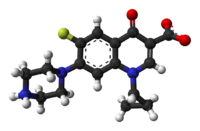
Back Siprofloksasien Afrikaans سيبروفلوكساسين Arabic Ciprofloxacino AST سیپروفلوکساسین AZB Ziprofloxazin BAR সিপ্রোফ্লক্সাসিন Bengali/Bangla Ciprofloxacina Catalan Ciprofflocsacin Welsh Ciprofloxacin Danish Ciprofloxacin German
 structure | |
 3D model of ciprofloxacin zwitterion | |
| Clinical data | |
|---|---|
| Trade names | Ciloxan, Cipro, Neofloxin, others |
| AHFS/Drugs.com | Monograph |
| MedlinePlus | a688016 |
| License data | |
| Pregnancy category |
|
| Routes of administration | By mouth, intravenous, topical (ear drops, eye drops) |
| Drug class | Fluoroquinolone |
| ATC code | |
| Legal status | |
| Legal status | |
| Pharmacokinetic data | |
| Bioavailability | 70%[4] |
| Protein binding | 30%[4] |
| Metabolism | Liver |
| Elimination half-life | 3.5 hours[4] |
| Excretion | Kidney |
| Identifiers | |
| |
| CAS Number | |
| PubChem CID | |
| DrugBank | |
| ChemSpider | |
| UNII | |
| KEGG | |
| ChEBI | |
| ChEMBL | |
| NIAID ChemDB | |
| CompTox Dashboard (EPA) | |
| ECHA InfoCard | 100.123.026 |
| Chemical and physical data | |
| Formula | C17H18FN3O3 |
| Molar mass | 331.347 g·mol−1 |
| 3D model (JSmol) | |
| |
| |
| (verify) | |
Ciprofloxacin is a fluoroquinolone antibiotic used to treat a number of bacterial infections.[5] This includes bone and joint infections, intra-abdominal infections, certain types of infectious diarrhea, respiratory tract infections, skin infections, typhoid fever, and urinary tract infections, among others.[5] For some infections it is used in addition to other antibiotics.[5] It can be taken by mouth, as eye drops, as ear drops, or intravenously.[5][6]
Common side effects include nausea, vomiting, and diarrhea.[5] Severe side effects include an increased risk of tendon rupture, hallucinations, and nerve damage.[5] In people with myasthenia gravis, there is worsening muscle weakness.[5] Rates of side effects appear to be higher than some groups of antibiotics such as cephalosporins but lower than others such as clindamycin.[7] Studies in other animals raise concerns regarding use in pregnancy.[8] No problems were identified, however, in the children of a small number of women who took the medication.[8] It appears to be safe during breastfeeding.[5] It is a second-generation fluoroquinolone with a broad spectrum of activity that usually results in the death of the bacteria.[5][9][10]
Ciprofloxacin was patented in 1980 and introduced in 1987.[11][12] It is on the World Health Organization's List of Essential Medicines.[13][14] The World Health Organization classifies ciprofloxacin as critically important for human medicine.[15] It is available as a generic medication.[5][16] In 2021, it was the 141st most commonly prescribed medication in the United States, with more than 4 million prescriptions.[17][18]
- ^ "Ciprofloxacin Use During Pregnancy". Drugs.com. 7 January 2019. Retrieved 19 December 2019.
- ^ "FDA-sourced list of all drugs with black box warnings (Use Download Full Results and View Query links.)". nctr-crs.fda.gov. FDA. Retrieved 22 October 2023.
- ^ "Cipro- ciprofloxacin hydrochloride tablet, film coated; Cipro- ciprofloxacin kit". DailyMed. 31 January 2023. Retrieved 9 February 2024.
- ^ a b c Zhanel GG, Fontaine S, Adam H, Schurek K, Mayer M, Noreddin AM, et al. (2006). "A Review of New Fluoroquinolones: Focus on their Use in Respiratory Tract Infections". Treatments in Respiratory Medicine. 5 (6): 437–465. doi:10.2165/00151829-200605060-00009. PMID 17154673. S2CID 26955572.
- ^ a b c d e f g h i j "Ciprofloxacin Hydrochloride". The American Society of Health-System Pharmacists. Archived from the original on 23 September 2015. Retrieved 23 August 2015.
- ^ "Ciprofloxacin Hcl Drops". WebMD. 22 February 2018. Retrieved 22 February 2018.
- ^ Heidelbaugh JJ, Holmstrom H (April 2013). "The perils of prescribing fluoroquinolones". The Journal of Family Practice. 62 (4): 191–197. PMID 23570031.
- ^ a b "Prescribing medicines in pregnancy database". Government of Australia. 23 August 2015. Archived from the original on 8 April 2014.
- ^ Ball P (July 2000). "Quinolone generations: natural history or natural selection?". The Journal of Antimicrobial Chemotherapy. 46 Suppl T1: 17–24. doi:10.1093/oxfordjournals.jac.a020889. PMID 10997595.
- ^ Oliphant CM, Green GM (February 2002). "Quinolones: a comprehensive review". American Family Physician. 65 (3): 455–464. doi:10.1016/s0022-5347(17)67120-9. PMID 1185862.
- ^ Oxford Handbook of Infectious Diseases and Microbiology. OUP Oxford. 2009. p. 56. ISBN 978-0-19-103962-1. Archived from the original on 8 September 2017.
- ^ Fischer J, Ganellin CR (2006). Analogue-based Drug Discovery. John Wiley & Sons. p. 500. ISBN 978-3-527-60749-5.
- ^ World Health Organization (2019). World Health Organization model list of essential medicines: 21st list 2019. Geneva: World Health Organization. hdl:10665/325771. WHO/MVP/EMP/IAU/2019.06. License: CC BY-NC-SA 3.0 IGO.
- ^ World Health Organization (2021). World Health Organization model list of essential medicines: 22nd list (2021). Geneva: World Health Organization. hdl:10665/345533. WHO/MHP/HPS/EML/2021.02.
- ^ World Health Organization (2019). Critically important antimicrobials for human medicine (6th revision ed.). Geneva: World Health Organization. hdl:10665/312266. ISBN 978-92-4-151552-8.
- ^ Hamilton RJ (2014). Tarascon pharmacopoeia (15th ed.). Jones & Bartlett Publishers. p. 85. ISBN 978-1-284-05671-6. Archived from the original on 8 September 2017.
- ^ "The Top 300 of 2021". ClinCalc. Archived from the original on 15 January 2024. Retrieved 14 January 2024.
- ^ "Ciprofloxacin - Drug Usage Statistics". ClinCalc. Retrieved 14 January 2024.
© MMXXIII Rich X Search. We shall prevail. All rights reserved. Rich X Search